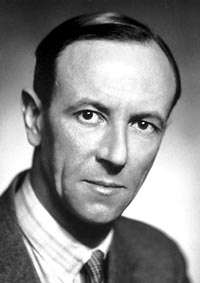
| Born: Oct 20, 1891 in Bollington, Cheshire, England |
| Died: Jul 24, 1974 (at age 82) in Cambridge, England |
| Nationality: English |
| Famous For: Discovery of the neutron and Manhattan Project |
| Awards: Hughes Medal (1932), Nobel Prize in Physics (1935), Knight Bachelor (1945), Copley Medal (1950), Franklin Medal (1951) and Companion of Honour (1970) |
James Chadwick was a British Nobel Prize-winning physicist. He received the honor in 1935 for his discovery of the neutron. Later in his career, Chadwick was most prominent as the leader of the British team that assisted with the Manhattan Project to develop an atomic weapon during World War Two. He was awarded a knighthood at the end of the war.
Early life
Chadwick was born in Manchester, England on October 20th, 1891. After a promising but unexceptional career at school, he managed to gain a place at the city’s Victoria University to study physics. This was, in fact, the result of a mistake on the part of the admissions board, since Chadwick had shown more of an interest in mathematical study. His shyness and lack of confidence as a young man prevented him from confronting the university about the error, and he took a degree in physics, graduating successfully in 1911. He then undertook postgraduate research, sometimes working alongside the renowned Ernest Rutherford.
Further Study and Discoveries
While at the university’s department of physics, Chadwick became acquainted with scientists of the caliber of Hans Geiger and Niels Bohr, among the foremost physicists of their day. He spent his time developing the planetary theory of the atom, and had achieved a Master’s degree by 1913. For his work, he was given the Exhibition Scholarship, which had been set up after the Great Exhibition of 1851.
Chadwick used the funds that this brought to go to study in Germany at the country’s first specialized research institution near Berlin. Here, Geiger was his ultimate superior, an arrangement which suited Chadwick very well. His own research brought advances such as knowledge of the energy range of beta particles, something which Wolfgang Pauli later used to help develop his own theory that the particle, now known as the neutrino, must exist.
Working With Rutherford
During World War One, Chadwick worked in Ruhleben, in a camp set up for German civilians. After the war ended, he took up a post at Cambridge University, in the world famous Cavendish Laboratory. Here, he renewed his partnership with Rutherford, and produced pioneering experiments that allowed the electrical charge of a nucleus to be determined directly. In 1922, he was appointed as director of research, working directly under Rutherford himself. The two men worked closely as they attempted to turn one element into another by means of splitting the nucleus.
By analyzing the irregularities that they found in their results, Chadwick and Rutherford came to realize that each element had its own specific atomic number and mass. They also found that the latter was always higher than the former. Rutherford’s theory was that this could be caused by neutrally-charged particles with the mass of a single proton. However, the duo was unable to show the existence of any such particle, and the hypothesis was dropped.
Later life
Eventually, Chadwick performed an experiment in which nitrogen was subjected to radiation, producing a substantial amount of energy as a result. He demonstrated that this result could only have been produced by the coming together of uncharged particles, each with about the mass of a proton. For discovering these particles, which he dubbed neutrons, he won his Nobel Prize. In the 1940’s he worked extensively on the Manhattan Project and attended the first nuclear test in New Mexico. After WWII he worked for the United Kingdom’s Atomic Energy Authority, retiring in 1962. He died in Cambridge in July, 1974.